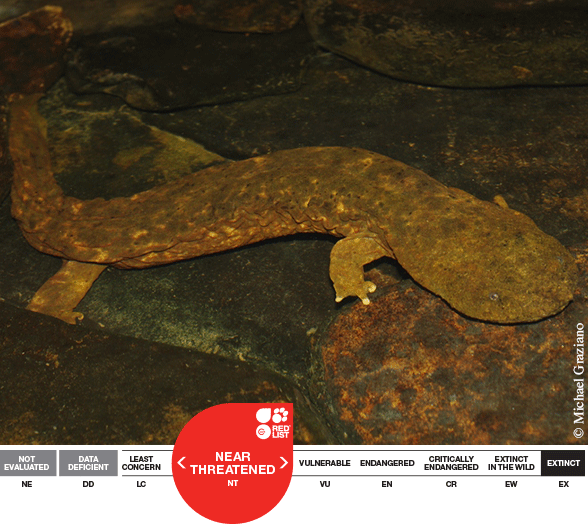
The Hellbender, Cryptobranchus alleganiensis, is listed as ‘Near Threatened’ on the IUCN Red List of Threatened Species™. It is found in the United States in large areas of Kentucky, Tennessee, and Pennsylvania, as well as in smaller areas of the surrounding states. Its distribution seems to follow the Appalachian Mountains until Eastern New York. There are two subspecies of Hellbenders, the Ozarks Hellbender (Cryptobranchus alleganiensis bishopi) and the Eastern Hellbender (Cryptobranchus alleganiensis alleganiensis). Both can grow up to three-quarters of a meter long and are known for being the largest salamander in North America.
The primary threat to Hellbenders is degradation of habitat, as it has little tolerance for environmental change in their preferred habitat of clear, fast-flowing rocky rivers and streams. These include chemical and thermal pollution of water, construction of dams, and activities that cause sedimentation in nest sites. Some fishermen believe the Cryptobranchus alleganiensisHellbender destroys their game fish, and thus kill them. Over-collecting of Hellbenders as live animals has also been a serious threat in some areas.
The Hellbender is well protected in certain areas, such as national forests, national parks, and other public lands. There are captive breeding programs for both subspecies with the Saint Louis Zoo successfully hatching over 1,000 Ozarks Hellbender this past winter and the Buffalo Zoo working with State Fish and Game to breed and release Eastern Hellbender larvae. Possible future conservation efforts could include educating fishermen about the species, as well as cessation of activities that cause sedimentation in their native rivers. A recent study of Hellbender genetics showed low genetic diversity within populations possibly due to recent reductions in population sizes, so conservation should also focus on preserving the remaining genetic diversity that does exist in each population.
